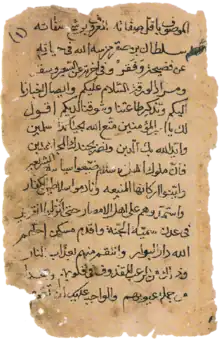| Farah Guled سلطان فارح بن جوليد | |
|---|---|
| Sultan of Isaaq | |
| Reign | 1808–1845 |
| Predecessor | Guled Abdi |
| Successor | Hassan Farah |
| Dynasty | Guled Dynasty |
| Religion | Sunni Islam |
Farah Guled (Somali: Faarax Guuleed, Arabic: فارح بن جوليد) was a Somali ruler. He was the second Grand Sultan of the Isaaq Sultanate and also a Hajji having completed pilgrimage to Mecca.[1]
Biography

Son of Sultan Guled, he was amongst the first generation of the Ba Ambaro branch of the emerging Guled dynasty, Farah was a member of the Eidagale branch of the Garhajis subclan of Isaaq.[2][3]
Message to Saqr al Qasimi
When a British vessel named the Mary Anne attempted to dock in Berbera's port in 1825 it was attacked and multiple members of the crew were massacred by the Isaaq. In response the Royal Navy enforced a blockade and some accounts narrate a bombardment of the city.[4] In 1827 two years later the British arrived and extended an offer to relieve the blockade which had halted Berbera's lucrative trade in exchange for indemnity. Following this initial suggestion the Battle of Berbera 1827 would break out. After the Isaaq defeat, 15,000 Spanish dollars was to be paid by the Isaaq leaders for the destruction of the ship and loss of life.[5] In the 1820s the Isaaq Sultan Farah Guled penned a letter to Sultan bin Saqr Al Qasimi of Ras Al Khaimah requesting military assistance and joint religious war against the British.[6] This would not materialize as Sultan Saqr was incapacitated by prior Persian Gulf campaign of 1819 and was unable to send aid to Berbera. Alongside their stronghold in the Persian Gulf & Gulf of Oman the Qasimi were very active both militarily and economically in the Gulf of Aden and were given to plunder and attack ships as far west as the Mocha on the Red Sea.[7] They had numerous commercial ties with the Somalis, leading vessels from Ras Al Khaimah and the Persian Gulf to regularly attend trade fairs in the large ports of Berbera and Zeila and were very familiar with the Isaaq.[8][9]
See also
References
- ↑ Al Qasimi, Sultan bin Muhammad (1996). رسالة زعماء الصومال إلى الشيخ سلطان بن صقر القاسمي (in Arabic). p. ١٩.
- ↑ Carlos-Swayne, Harald. Seventeen Trips Through Somaliland and a Visit to Abyssinia: with supplementary preface on the 'Mad Mullah' risings. pp. 15–20.
- ↑ Genealogies of the Somal. Eyre and Spottiswoode (London). 1896.
- ↑ Laitin, David D. (1977). Politics, Language, and Thought: The Somali Experience. 9780226467917. p. 70. ISBN 9780226467917.
- ↑ Laitin, David D. (1977). Politics, Language, and Thought: The Somali Experience. 9780226467917. p. 70. ISBN 9780226467917.
- ↑ Al Qasimi, Sultan bin Muhammad (1996). رسالة زعماء الصومال إلى الشيخ سلطان بن صقر القاسمي (in Arabic). p. ١٧.
- ↑ Davies, Charles E. (1997). The Blood-red Arab Flag: An Investigation Into Qasimi Piracy, 1797-1820. University of Exeter Press. p. 167. ISBN 9780859895095.
- ↑ Pankhurst, Richard (1965). "The Trade of the Gulf of Aden Ports of Africa in the Early Nineteenth and Early Twentieth Centuries". Journal of Ethiopian Studies. 3 (1): 36–81.
- ↑ Al Qasimi, Sultan bin Muhammad (1996). رسالة زعماء الصومال إلى الشيخ سلطان بن صقر القاسمي (in Arabic). p. ١٢.